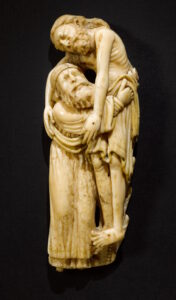 The V&A museum has launched a campaign to raise the £2 million it needs to acquire the rare 12th century walrus ivory carving that will otherwise leave the UK and enter the collection of the Metropolitan Museum of Art.
The V&A museum has launched a campaign to raise the £2 million it needs to acquire the rare 12th century walrus ivory carving that will otherwise leave the UK and enter the collection of the Metropolitan Museum of Art.
The Deposition from the Cross is a depiction of Joseph of Arimathea taking the body of Christ down from the cross. The meticulous detail — the finely striated hair and beards, the soft draping of the robes — make it one of the greatest surviving examples of English Romanesque ivory carving. Thought to have been crafted in York, North Yorkshire, in around 1190, it was originally part of a larger altarpiece with multiple scenes from the Passion of the Christ. Today only this fragment and a much smaller fragment of Judas eating the bread dipped in wine Jesus passed to him marking him as the betrayer, are known to survive from this altarpiece. The V&A already owns the Judas fragment.
The Met bought the carving in a private sale last year but its application for an export license was deferred on the grounds that its exceptionally fine carving and rarity make it a work of national importance. The UK Arts Minister placed a temporary export bar on the Deposition to give a local museum the opportunity to raise the purchase price and keep the carving in the country.
From Tristram Hunt, Director of the V&A:
“The Deposition from the Cross ivory is one of the most beautiful, entrancing and historically important items to have been on display at the V&A. It tells the story of humanism long before the Renaissance, and speaks to an elemental part of English culture. It is vital that we return it to display, for free, for everyone, forever.”
Why does this object belong at the V&A?
The Reviewing Committee on the Export of Works of Art and Objects of Cultural Interest have stated that the Deposition from the Cross is ‘one of the most culturally and aesthetically significant objects’ they have ever considered, and that this important work is of eminent importance for providing vital insights into a period of English history, from which very few objects have survived. The successful acquisition of the Deposition from the Cross by the V&A would allow for the sculpture to be re-united with the only known surviving piece of the same ensemble, a fragmentary ivory carving of Judas at the Last Supper, discovered in Wakefield during the 18th-century, which is currently in the V&A Collection.
The two pieces were on display together at the V&A from 1982 until 2022. The Deposition was on long-term loan, and was only removed from the museum when the owner decided to sell it.
The V&A has set up a donation button at the bottom of the page here. You check out with a credit card or PayPal just like buying something from the museum’s online store.
I like things staying in the country of origin but at least either way, it would be in a museum where people can sew it for free. I would hate for a private collector to hoard it away.